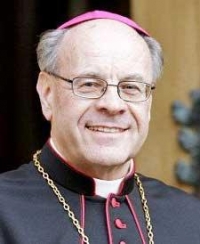+
JMJ
... NOT!Of course I'm just referring to the resistance rumour (posted in January) that the SSPX had received a mandate to consecrate 2 bishops, that the consecrations would happen at the end of April and ... it didn't happen.
What has happened is that Bishop Huonder is retiring to a house of the SSPX.
On Monday, May 20, 2019, Pope Francis relieved Bishop Vitus Huonder of his duties as Bishop of the Diocese of Chur (Switzerland), while appointing an administrator with a view to the election of his successor.
According to an intention that he stated long ago, Bishop Huonder is retiring to a house of the Society of Saint Pius X. The one sole purpose of this step is to dedicate himself to prayer and silence, to celebrate the traditional Mass exclusively, and to work for Tradition, the only way of renewing the Church.
The Society of Saint Pius X appreciates Bishop Huonder’s courageous decision and rejoices to be able to provide him with the spiritual and priestly surroundings that he desires so deeply. May this example be followed by others, so as to “restore everything in Christ”.
May 20, 2019
His Excellency Vitus Huonder Don Davide Pagliarani
Bishop Emeritus of Chur Superior General of the SSPX
Courtesy of FSSPX.news.
Rorate had been one of the earliest to report this (I can't remember if they preceded the resistance)
Courtesy of Rorate-CaeliAs first revealed by Rorate, Bishop of major Swiss diocese retiring to SSPX house
In January, Rorate was the first English language venue to reveal (and confirm) that the bishop of Church, the major Swiss diocese that includes the financial center of the country, Zurich, was planning on spending his retirement in a house belonging to the Society of Saint Pius X (SSPX).Today, the Holy See announced the retirement of Bishop Huonder, and a joint communique by the Bishop and the SSPX confim it.It was obviously all done with the full knowledge of the Pope (even if it goes unmentioned). It is another step in the full "regularization" of the Society (read this to understand it).
Of interest is the second article linked by Rorate that describes the current status of the SSPX. It provides a handy list of the steps (concessions?) made by Rome towards the regularization of the SSPX's canonical situation. Côme de Prévigny make the assertion that the "canonical situation of the Society of St. Pius X is mostly normalized" and supports the assertion with the following observations:
- The Mass that its members celebrate is the same that all priests of the world can recite or sing following the Motu Proprio Summorum Pontificum, of July 7, 2007.
- The condemnations that weighed on the bishops of the Society were lifted by a decree signed of January 21, 2009.
- In 2015, the Holy See granted to its Superior-General the powers to judge on the first level of jurisdiction.
- The validity of the confessions heard by its priests was recognized by the Apostolic Letter Misericordia et Misera, of November 20, 2016.
- In 2016, the Pontifical Commission Ecclesia Dei asked the bishops of the dioceses in which Society seminaries are situated to accept the ceremonies of ordinations that take place in them.
- Marriages celebrated before Society priests are at last fully recognized by Rome, as attested by a letter of the Congregation for the Doctrine of the Faith, of March 27, 2017.
- Society priests [are] to send registries proving the celebration of marriages to diocesan chanceries.
- These registries are to be organized along with the registries of all parishes and communities in fully regular situation.
- Implicitly, since the sanctions have disappeared and since its priests have received the canonical charge to administer the several Sacraments, the Society has found anew its original status, which had been abolished on May 6, 1975, and behaves, de facto, as a personal prelature.


Comments
Post a Comment